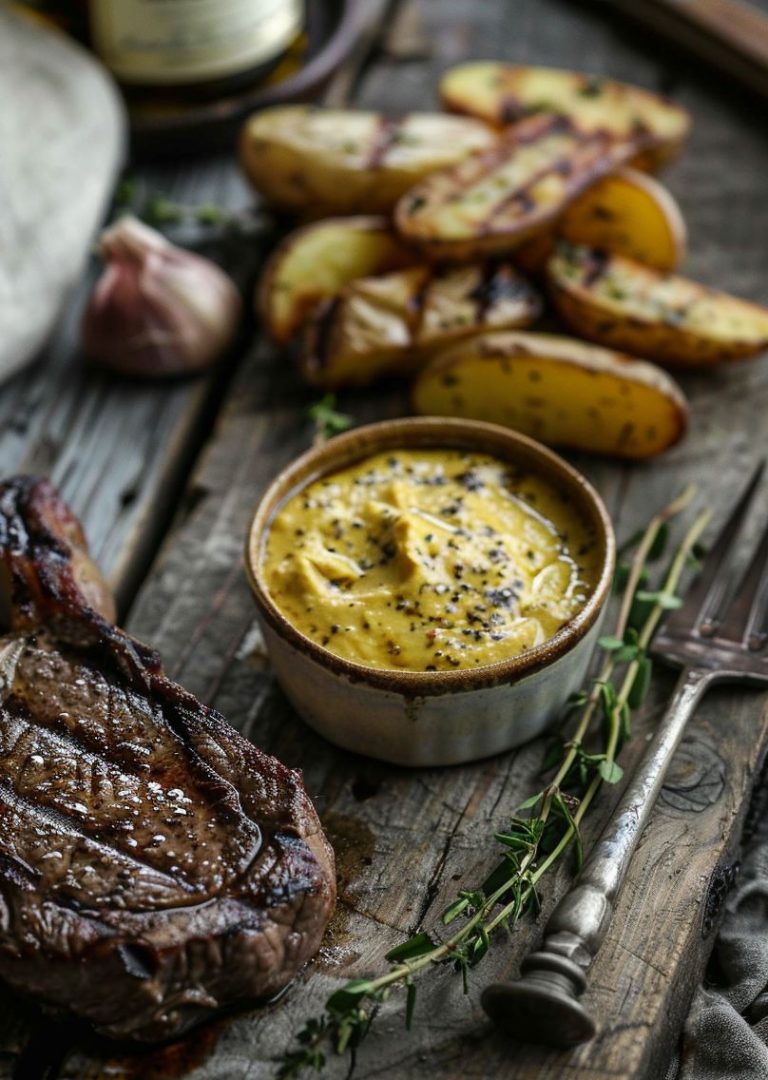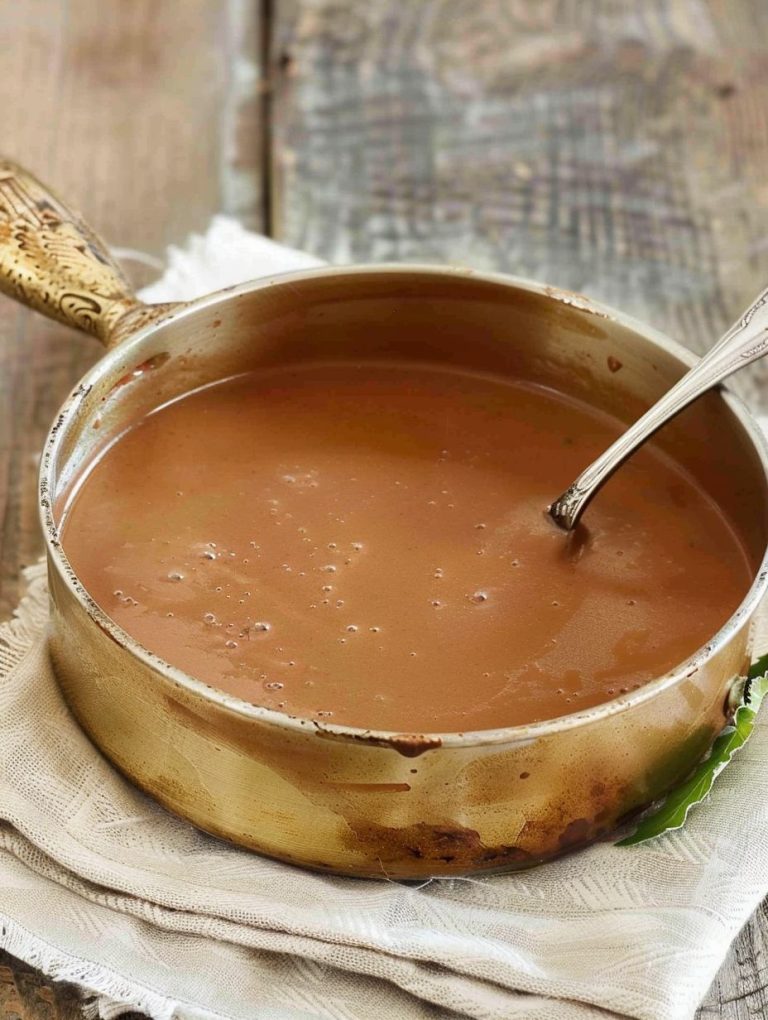How to Make Velouté Sauce (French Recipe)
We may earn a commission through all links on this website. As an Amazon Associate, we earn from qualifying purchases.Velouté sauce is one of the five mother sauces in French cuisine. It is a white sauce made by combining a roux (a mixture of butter and flour) with a light stock, such as chicken, fish, or veal. The sauce is then simmered until it thickens and has a smooth, creamy texture.
Velouté sauce can be seasoned with salt, pepper, and other herbs and spices, and can be used as a base for other sauces or served on its own with various dishes, such as chicken, fish, vegetables, or eggs. It is a versatile sauce that can be made in different variations, such as using different types of stock or adding cream or egg yolks for richness.
How to Make Classic Velouté Sauce
Here is a classic velouté sauce recipe:
Ingredients:
- 4 tablespoons unsalted butter
- 4 tablespoons all-purpose flour
- 4 cups chicken or veal stock, warmed
- Salt and freshly ground black pepper
Instructions:
- In a medium saucepan, melt the butter over medium heat.
- Add the flour and whisk until smooth. Cook the roux for 2 to 3 minutes, stirring constantly, until it turns light brown and has a nutty aroma.
- Gradually add the warmed chicken or veal stock to the roux, whisking constantly to prevent lumps from forming.
- Increase the heat to medium-high and bring the mixture to a simmer, whisking frequently.
- Reduce the heat to low and let the sauce simmer for 10 to 15 minutes, stirring occasionally, until it thickens and coats the back of a spoon.
- Season the sauce with salt and freshly ground black pepper to taste.
- If you want a smoother texture, you can strain the sauce through a fine-mesh sieve before using it.
This classic velouté sauce recipe can be used as a base for other sauces or served on its own with various dishes, such as chicken, fish, or vegetables. You can also experiment with different variations of velouté sauce, such as adding cream or egg yolks for richness, or using different types of stock for different flavors.
Main Liquid Base
The main liquid base in velouté sauce is a light-colored stock, such as chicken, veal, or fish stock. The stock is typically simmered with a roux made from butter and flour until it thickens and has a smooth, creamy texture. The ratio of roux to stock can vary depending on the desired thickness of the sauce, but the general rule of thumb is equal parts butter and flour by weight to an equal volume of stock.
History of Velouté Sauce
Velouté sauce has a long history in French cuisine and is one of the five mother sauces that form the foundation of French cooking. The sauce was developed during the 17th century by the French chef François La Varenne, who is considered one of the fathers of modern French cuisine.
François Pierre de la Varenne was a French chef who lived in the 17th century and is considered one of the founders of French cuisine. He is known for his influential cookbook, “Le Cuisinier François” (The French Cook), which was first published in 1651.
In his cookbook, La Varenne included a recipe for “velouté de poulet,” which was a simple sauce made from chicken and a roux of butter and flour.
Marie-Antoine Carême was a French chef who lived in the early 19th century and is considered one of the greatest chefs in history. Carême was known for his mastery of French cuisine and his contributions to the development of many classic French dishes and sauces, including velouté sauce.
Carême praised velouté sauce for its versatility and adaptability, calling it “the most beautiful and delicate of all the sauces.”
How to Use Velouté Sauce
Velouté sauce is a versatile sauce that can be used in a variety of dishes to add flavor and creaminess. Here are some common velouté sauce uses:
As a base for other sauces: Velouté sauce is one of the mother sauces in French cuisine, and it serves as a base for other sauces, such as sauce allemande (velouté sauce with egg yolks and cream), sauce suprême (velouté sauce with cream and mushrooms), and sauce Bercy (velouté sauce with white wine and shallots).
With poultry: Velouté sauce is often served with poultry dishes, such as chicken, turkey, or quail. It can be used as a topping or served as a side sauce.
With fish and seafood: Velouté sauce pairs well with fish and seafood dishes, such as poached fish, seafood gratin, or seafood stew.
With vegetables: Velouté sauce can be used as a creamy sauce for vegetable dishes, such as asparagus, artichokes, or cauliflower.
Types of Velouté
There are several types of velouté sauce, each made by using a different type of stock or adding different ingredients. Here are some common types of velouté sauce:
White velouté sauce: This is the basic version of velouté sauce made with white stock, such as chicken or veal stock, and a roux of butter and flour. It has a delicate flavor and can be used as a base for other sauces.
Blonde velouté sauce: This type of velouté sauce is made with a light chicken or fish stock, which gives it a pale color and a mild flavor. It is often used with fish and seafood dishes.
Mushroom velouté sauce: This version of velouté sauce is made by adding sautéed mushrooms to the basic white velouté sauce. It has a rich, earthy flavor and can be used as a base for mushroom sauce or served with meat dishes.
Allemande sauce: Also known as sauce Parisienne, allemande sauce is a variation of velouté sauce made by adding egg yolks and heavy cream. It has a rich, velvety texture and is often served with veal or poultry dishes.
Suprême sauce: This type of velouté sauce is made by adding heavy cream and chopped mushrooms to the basic white velouté sauce. It has a rich, creamy flavor and is often used with poultry dishes.
Velouté Derivatives
Here are some common velouté sauce derivatives:
Sauce Normandy: This sauce is made by adding apple cider and cream to velouté sauce. It is often served with pork or chicken dishes.
Sauce vin blanc: This sauce is made by adding white wine, shallots, and cream to velouté sauce. It has a tangy, wine flavor and is often served with fish or seafood dishes.
Sauce Bercy: This sauce is made by adding white wine, shallots, and parsley to velouté sauce. It has a light, herby flavor and is often served with fish or seafood dishes.
Sauce Aurora: This sauce is made by adding tomato paste and cream to velouté sauce. It has a rich, pink color and is often served with pasta or chicken dishes.
Velouté vs Gravy
What is the difference between velouté and gravy? Velouté sauce and gravy are both liquid accompaniments used to enhance the flavor and texture of a dish, but they differ in their ingredients and preparation methods.
Velouté sauce is a French mother sauce made by combining a white roux (a mixture of flour and butter) with a light-colored stock, such as chicken, veal, or fish. The mixture is simmered until it thickens and becomes smooth, and it can be seasoned with salt, pepper, and other herbs and spices. Velouté sauce has a rich, creamy texture and can be used as a base for other sauces or served on its own with various dishes, such as chicken, fish, or vegetables.
Gravy, on the other hand, is a sauce made from the juices and drippings of cooked meat, typically poultry or beef. The drippings are combined with flour and a liquid, such as stock or wine, and simmered until the mixture thickens and becomes smooth. Gravy is usually seasoned with salt, pepper, and other herbs and spices, and it has a rich, savory flavor that complements the meat it accompanies.



